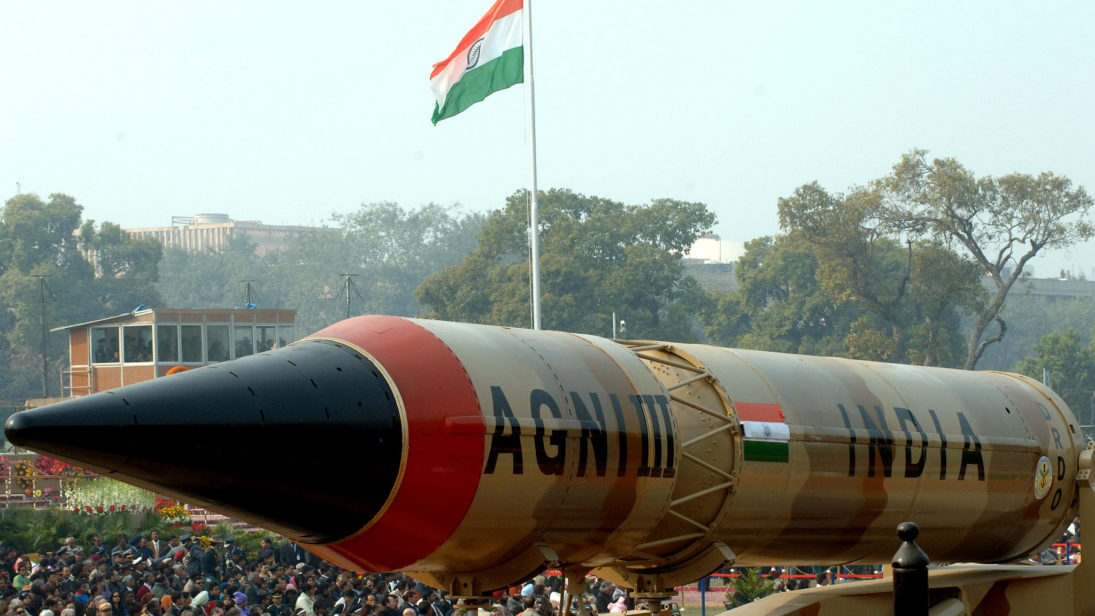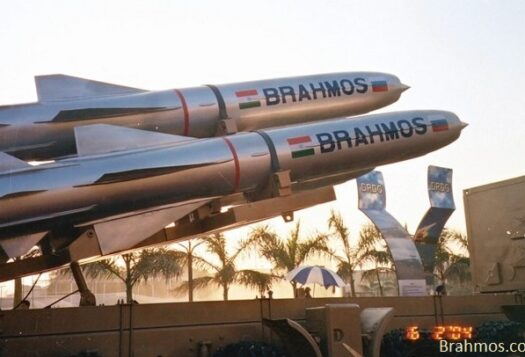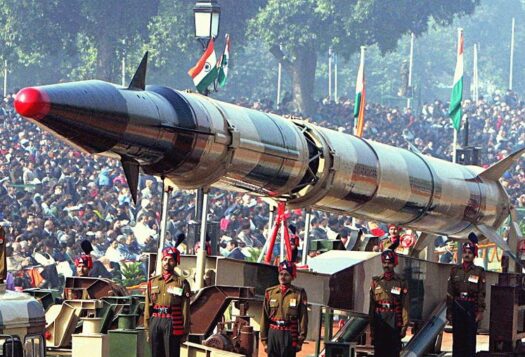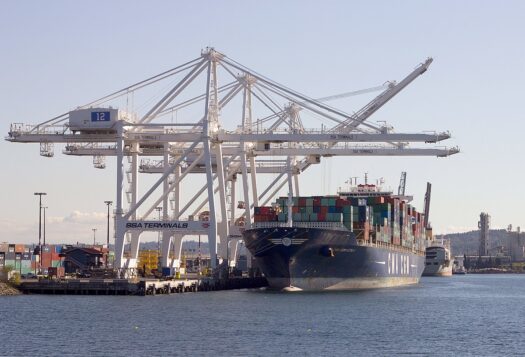
The use of nuclear weapons against a state’s adversary is a critical component of deterrence policy. Understanding the importance of this, India adheres to a no first use (NFU) nuclear doctrine. Despite the apparent devotion to NFU, analysts and scholars have questioned how serious the Indian government is about this hallmark of its nuclear doctrine. Kumar Sundaram and M.V. Ramana raise important questions in their article “India and the Policy of No First Use of Nuclear Weapons” (2018) in the Journal for Peace and Nuclear Disarmament. This review examines the merits of their argument: its strengths, weaknesses, and areas to expand upon in the future.
Strengths
The article emphasizes NFU as a “core element of India’s nuclear weapons posture” that has been challenged by its critics over time. The authors have questioned India’s NFU commitment by contextualizing the viewpoints of several strategic thinkers. They argue that NFU is “neither a stable nor a reliable predictor” of the circumstances under which the political or military establishment would adopt the nuclear option. Finally, India’s ongoing military modernization and its refusal to participate in the 2017 Ban Treaty negotiations strengthen their speculations on India’s commitment to NFU in times of crisis.
The article’s strength lies in the excellent exposition in articulating the rationale for NFU through the view of its two advocates, General K. Sundarji and K. Subrahmanyam. Propounded by this interesting duo of military and national security experts, the authors have justly outlined the efficacy of the NFU. While Sundarji perceived a unilateral declaration of NFU as “axiomatic” for India-Pakistan diplomatic stability, Subrahmanyam argued that NFU might steer towards a “global protocol to outlaw the first-use of [nuclear weapons].”
Weaknesses
Despite the article’s strengths, the authors’ argument against India’s commitment rests on misinterpreted evidence and faulty logic. One of the scholars they cite is Vipin Narang, who has written that there is a “potential grey area” in which India would abandon NFU. Critiquing Shivshankar Menon’s NFU position in Choices: Inside the Making of India’s Foreign Policy, Narang interprets that India’s nuclear doctrine may allow for preemptive nuclear use. In the book, Menon postulates that Pakistan’s offensive strategy to use tactical nuclear weapons (TNWs) against India would effectively leave India with the option of a “comprehensive first-strike.” The use of the term first-strike caused much uproar at the time, since first-strike denotes an offensive posture. However, in the passage Narang cites, Menon clearly indicates that Pakistan’s use of TNWs against Indian forces would constitute first use, which would “effectively be opening the door to a massive Indian first strike, having crossed India’s declared red lines.” This passage constitutes no guiding principle of India’s nuclear doctrine. It is also a far cry from denoting that there is any shift in India’s nuclear posture towards a counterforce strategy. As emphasized by Menon, “the primary purpose of our weapons of deterring blackmail, threat, or use of nuclear weapons by an adversary against India” remains consistent.
India has not responded to Islamabad’s warfighting nuclear posture with aggression. To the contrary, New Delhi has reacted in a restrained manner, upholding a credible minimum deterrence premised upon a modest nuclear arsenal, a NFU policy, and determination to inflict unacceptable damage only if its national interests is endangered.
The authors have raised concerns over India’s decision to canisterize its Agni-V systems, which indicates that the missiles could be mated with their warheads. Canisterizing requires missiles to be kept in ready-to-launch mode, implying mating the nuclear warheads to the missiles, which contradicts India’s de-mated missile positioning status. The article interprets India’s decision to canisterize as a radical shift in India’s nuclear deployment strategy. However, this interpretation ignores the fact that a critical requirement of a second-strike capability is reducing the response time to a nuclear attack with its survivable nuclear weapons. India’s retaliatory posture is contingent on both the assurance and speed of a response. It implies that India’s holds a credible threat to deter even as it adheres to its enduring strategic restraint posture. With Pakistan, the regional strategic calculus is badly disturbed with the presence of Pakistan-supported terrorist organizations in India-administered Kashmir that pose security threats to India and frequent communication of its nuclear warfighting posture. Despite Pakistan’s India-specific and rapidly expanding nuclear weapons program based upon “full spectrum deterrence” and TNWs, India has not responded to Islamabad’s warfighting nuclear posture with aggression. To the contrary, New Delhi has reacted in a restrained manner, upholding a credible minimum deterrence premised upon a modest nuclear arsenal, a NFU policy, and determination to inflict unacceptable damage only if its national interests is endangered.
A deterrence posture is credible when inter alia it comprises the ability to convey its intention, will, and determination to carry out assured retaliation against any nuclear misadventure. Thus, A.B. Vajpayee’s response in February 2000 on India’s reaction to possible threats of Pakistani nuclear attacks (“If they think we will wait for them to drop a bomb and face destruction, they are mistaken”) is unfair. The late prime minister’s statement clearly denotes that it was a mistake to presume that any attack can be directed against it without retaliation posing unacceptable consequences on the adversary; it essentially conveys the credibility of India’s threat. Hence, the authors’ assessment that Vajpayee indicated a preemptive attack against any Pakistani misadventure is misconceived.
Noteworthy, the authors have further raised speculations that domestic political considerations influence India’s nuclear posture. Domestic debates are a cardinal aspect of any democratic system. On the nuclear front, regular domestic debates allow revisiting the nuclear doctrine to test its efficacy. Experts have sparked intense debates on various issues like whether India should develop TNWs given Pakistan’s evolving nuclear posture and the India-U.S. nuclear deal. However, national interest considerations have finally guided India’s nuclear policy. India’s position is evident from its refusal to accede to any domestic pressure for revision of the NFU in its history as a nuclear power.

Conceptualizing India’s NFU
The existence of any offensive doctrine promoting first-use and willingness to use nuclear weapons against non-nuclear weapons states constitutes a threat to strategic stability. This rationale guided India to extend “no-first-use of nuclear capability” to Pakistan in 1994. Nonetheless, NFU does entail a retaliatory posture, albeit with second-strike capability. The rationale of a second-strike capability is linked to whether India has a credible doctrine buttressed with requisite capabilities and assets. Shyam Saran’s authoritative 2014 piece supports the rationale behind a massive retaliation to a TNW attack. He adumbrates the efficacy of a credible deterrent posture as a “potent instrument for deterrence against powerful and inimical adversaries.” This is in line with India’s declaratory statements, which must not be regarded as merely declaratory. Hence, Saran has justly asserted that any suggestion to shift from NFU policy is “fallacious” despite debates for a revision of India’s stand. There appears no ambiguity on India’s position and commitment to NFU in either of the official documents. This position has been consistently reiterated by India.
Experts have emphasized the efficacy of NFU’s strategic restraint. Manpreet Sethi’s “No First Use of NW: Sane Logic, Sound Doctrine,” assesses NFU strategy as “far more credible and useful in the contemporary context.” She argues in favor of India’s NFU posture and combats the logic of first-use. After all, a first-strike cannot guarantee that a subsequent attack would be deterred. A strategic offensive posture provides no comfort that having resorted to a first-use, the adversary will have the stomach for nuclear retaliation and then claim it has come out better. As pointed out by Sethi, despite India having faced the threat of 16 times between 1991 and 2000, there has been no breakdown of deterrence. Evidently, this substantiates India’s commitment to the NFU, which rests on the basic edifice of a posture of strategic restraint.
NFU as a Diplomatic Tool
India’s NFU policy confers on India the status of a responsible nuclear power. It signifies India’s commitment to nonproliferation and the universal nuclear disarmament that harmonizes with the fundamental principles of humanitarian law. However, the authors interrogate “how India would reconcile a shift in its policy with the diplomatic image it has cultivated,” concluding that such an image could, in fact, allow for first-use “should the circumstances arise and the relevant policy makers decide to launch such an attack.”
It is unlikely that India would permit a scenario in which New Delhi uses nuclear weapons to arise given that the NFU doctrine’s diplomatic appeal has been a cardinal factor in the implementation of the India-U.S. nuclear deal in 2005 and the international community’s…convincing support for India’s NSG membership.
Ignoring the cynicism, as I have argued elsewhere, India’s conventional strength and its Cold Start doctrine is sufficient to neutralize any Pakistani conventional aggression. Moreover, India’s strategic culture is embedded in the philosophy of being reluctant nuclear state and a status-quo power bereft of any belligerent posture. The NFU policy as advocated by its early proponents has served as a diplomatic tool by removing ambiguity surrounding India’s responsibility as a nuclear-armed state, especially in contrast to Pakistan. This position has been clarified and reiterated by its diplomats in the United Nations. The authors recognize that NFU had “become a standard part of India’s nuclear thinking even prior to the 1998 nuclear tests.” Moreover, it is unlikely that India would permit a scenario in which New Delhi uses nuclear weapons to arise given that the NFU doctrine’s diplomatic appeal has been a cardinal factor in the implementation of the India-U.S. nuclear deal in 2005 and the international community’s (sans China and a handful of nations) convincing support for India’s NSG membership. Thus, the authors’ appeal that NFU has more bark than bite can be contradicted.
Avoiding Another Mushroom Cloud
The NFU policy is an important instrument of India’s nuclear diplomacy. Hence, any alteration in the NFU policy would impact upon South Asia’s strategic stability. The world has already witnessed the horrendous impact of the mushroom cloud. India’s advocacy of the NFU policy is a sagacious step to prevent the occurrence of any mushroom cloud in the region. However, India must ensure infrastructural support for an effective and credible nuclear deterrent that can assure a massive second-strike retaliation, without being corroded in any attempted first-strike.
Editor’s Note: In an ongoing series aimed at bridging the divide between policy analysis and academic scholarship, SAV contributors review recent articles and books published by leading scholars to evaluate the latest theoretical and analytical debates on strategic issues and their implications for South Asia. Read the series here.
***
Image 1: Public.Resource.Org via Flickr


